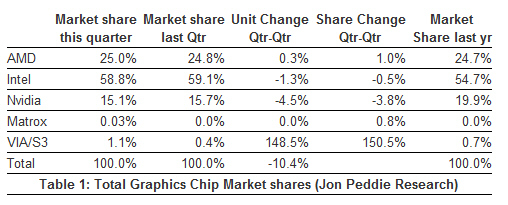griff30
Supreme [H]ardness
- Joined
- Jul 15, 2000
- Messages
- 7,212
Just curious about an upgrade, seems like this portion of the message board is looking like the Physics Processing/CueCat board 
Where did everyone go?
Where did everyone go?
Follow along with the video below to see how to install our site as a web app on your home screen.
Note: This feature may not be available in some browsers.
5% or so faster?
5% faster on an already abysmal CPU is going to make matters worse for AMD.
Why bother?
piledriver is due in agust but they will probably delay it for dumd reason.
Would love to see a plethora of models with 8, 12, and 16 real cores available for the consumer market segment, as well.
You would want to know at which speed they start if they don't have any problems with manufacturing.
you want a 16 core CPU .... for the consumer market. i bet those will sell really well ...C'mon, AMD! I'm really hoping that PD will be the a far cry better performer than BD and really reduce power consumption. Would love to see a plethora of models with 8, 12, and 16 real cores available for the consumer market segment, as well.
you want a 16 core CPU .... for the consumer market. i bet those will sell really well ...
Well why not? We will have more than 6 cores available in the consumer market eventually. It's inevitable.
the current top end 16 core bulldozer hits 2.6ghz/105W non turbo. an improved process plus the new gating thingy may push these to 3ghz ish non turbo.I believe you are either looking for miracles or you you will be okay if these were clocked at below 2 Ghz. That is except for the 8 core version.
the current top end 16 core bulldozer, the Opteron 6284 SE, runs at 2.7ghz on each core @ 140W. sorry was looking at old info in the last post.
Bingo! Was hoping someone would catch on to what I was saying earlier about 8, 12, and 16 core future models.
With architecture advancements and process shrinks, I think a 3.0+ GHz lower TDP part is attainable, and fairly easy, at that. AMD needs to push them into the mainstream and then mop up the cash. Would be an easy sell to average Joe or Mary since the perception of moar corze being better is the general mindset of the consumer base.
Of course, with that many cores, at those speeds, with lower TDP, it would very well be better.
they wouldn't sell at all, they're ~$1500 each.
Yeah, right now. If you're in the market for a server.
If AMD starts cranking them out in huge quantities specifically for the consumer market segment, they won't be nearly that expensive at all.
All their CPU's would have the initial intent to be 16 core models, it's just the units that don't meet the muster that get intentionally binned to lower speed or fewer core models. Doesn't cost anything more in manufacturing to make a 16 core vs a 4 core this way, for example.
^ you're still thinking in terms of today's process, not future renditions. With architectural and process changes, a single die 16 core will be coming along at some point.. again, the same things were argued about quad cores before those arrived in a single die.
You're still not explaining why a 16-core single die is better than an 8-core single die. There's no doubt that we'll have more and more coars, but expecting such massive transitions in both architecture and software is too far fetched. Even BD at 8 coars suffers today because of the lack of heavily-threaded software to redeem it, and on top of that it has castrated clock speeds and massive power consumption and a bigger die. It doesn't make sense today nor will it make sense next week, but when we get to a point where software is passively threaded then I'll change my point of view ;P
